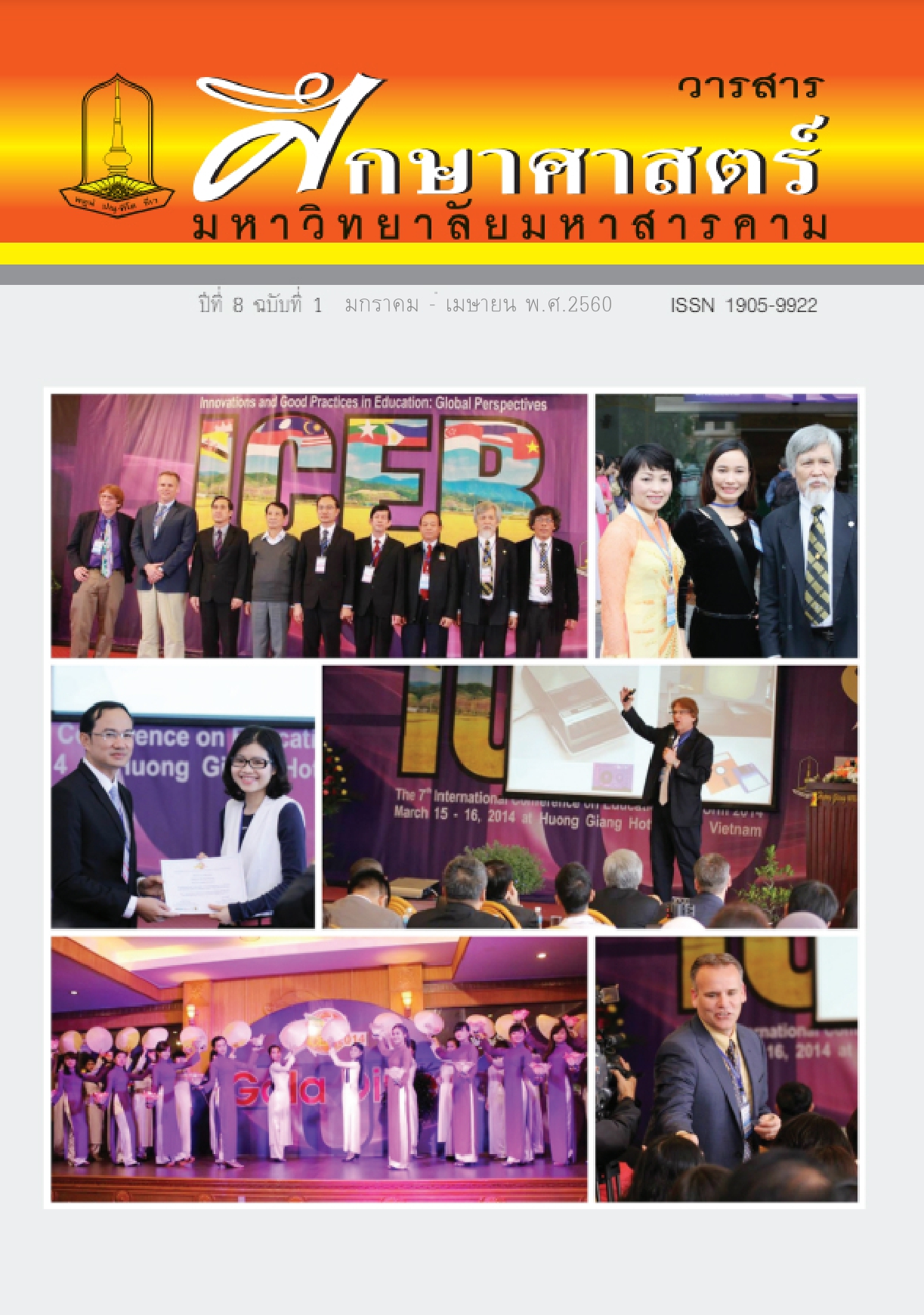The Development of Guidelines for Developing Teachers about Teaching by Using Brain-Based Learning for Schools under the Office of Udonthani Primary Educational Service Area 2
Main Article Content
Abstract
The purposes of this research were 1) to study the elements and indicators teaching by using brain-based learning for schools under the office of Udonthani primary education service, area 2 ; 2) to study the present condition, the desirable and the Modified Priority Needs Index of teaching by using brain-based learning for schools under the office of Udonthani primary education service area 2; and 3) to develop guidelines for developing teachers about teaching by using brain-based learning for schools under the office of Udonthani primary education service area 2. Research and development. Method was divided into three phases for the purposes of research. The samples were 457 teachers and school administrators, using stratified random sampling. Instruments used were questionnaire,assessment elements and indicators, interview form and assessment guidelines. Data were analyzed using mean standard devitation and modified priority needs index.
Research findings were as follows: 1. There are five elements nineteen indicators of teaching by using brain-based learning for schools include the conductive environment for learning, The relaxed atmosphere for learning, The encouragement students to learn, The learning process focused on the needs of the students and the encouragement students to learn on their own, the conductive environment for learning has four indicators, The relaxed atmosphere for learning has three indicators, The encouragement students to learn has three indicators, The learning process focused on the needs of the students has four indicators and the encouragement students to learn on their own has five indicators. 2. The present condition of teaching by using brain-based learning for schools under the office of Udonthani primary education service, area 2 overall at a high level. Considering each element, at a high all. The desirable of teaching by using brain-based learning for schools under the office of Udonthani primary education service, area 2 overall at the highest level. 3. Guidelines for developing teachers about teaching by using brain-based learning for Schools under the Office of Udonthani Primary Education Service Area 2 include that: 1) The conductive environment for learning consists of four guidelines. 2 ) The relaxed atmosphere for learning consists of three guidelines. 3) The encouragement students to learn consists of five guidelines. 4) The learning process focused on the needs of the students consists of five. 5) The encouragement students to learn on their own consists of four guidelines.
Downloads
Article Details
References
กระทรวงศึกษาธิการ. (2552). แนวทางพัฒนาการวัดและประเมินผลคุณลักษณะอันพึงประสงค์ตามหลักสูตรแกนกลางการศึกษาขั้นพื้นฐาน พุทธศักราช 2551. กรุงเทพฯ: โรงพิมพ์ชุมนุมสหกรณ์การเกษตรแห่งประเทศไทย.
โกวิท ประวาลพฤกษ์. (2548). Brain-Based Learning การเรียนรู้ที่สอดคล้องกับการทำ งานของสมองและสร้างพหุปัญญา (MI) ด้วยโครงงาน. กรุงเทพฯ: สถาบันพัฒนาวิชาการ (พว).
คณาจารย์ภาควิชาวิจัยและพัฒนาการศึกษา คณะศึกษาศาสตร์ มหาวิทยาลัยมหาสารคาม. (2553). พื้นฐานการวิจัยการศึกษา. พิมพ์ครั้งที่ 6. กาฬสินธุ์: ประสานการพิมพ์.
จารุณี ซามาตย์ และคณะ. (2551). การพัฒนาแนวคิดแนวปฏิบัติของครูเกี่ยวกับการจัดการเรียนรู้และการใช้นวัตกรรมการเรียนรู้ที่ส่งเสริมศักยภาพการเรียนรู้ทางสมองของผู้เรียน โดยใช้ BrainBased learning. ขอนแก่น: มหาวิทยาลัยขอนแก่น.
จิณวิภา ศรีพันธ์ชาติ. (2553). การพัฒนาบุคลากรด้านการจัดกิจกรรมการเรียนรู้โดยใช้สมองเป็นฐาน (BBL)โรงเรียนพิกุลแก้วศึกษา อำเภอเมือง จังหวัดขอนแก่น. การศึกษาค้นคว้าอิสระ กศ.ม.มหาสารคาม: มหาวิทยาลัยมหาสารคาม.
นริศรา เสือคล้าย. (2550). การวิจัยและพัฒนาแผนการจัดการเรียนรู้ตามแนวคิดการเรียนรู้โดยใช้สมองเป็นฐานเพื่อพัฒนาความสามารถทางการคิดของนักเรียนชั้นประถมศึกษา. วิทยานิพนธ์ครุศาสตรมหาบันฑิต สาขาวิชาวิจัยการศึกษา: จุฬาลงกรณ์มหาวิทยาลัย.
เบญจรัตน์ คุริรัง. (2555). การพัฒนาบุคลากรในการจัดประสบการณ์การเรียนรู้โดยการประยุกต์ใช้แนวคิดการใช้สมองเป็นฐาน BBL โรงเรียนเทศบาลวัดเวฬุวัน อำเภอเมือง จังหวัดร้อยเอ็ด.การศึกษาค้นคว้าอิสระ กศ.ม. มหาสารคาม: มหาวิทยาลัยมหาสารคาม.
ปทิตญา ธีรวัชรกร. (2557). การพัฒนาครูด้านการจัดการเรียนรู้แบบใช้สมองเป็นฐาน ระดับปฐมวัยโรงเรียนเทศบาลศรีสวัสดิ์วิทยา สังกัดกองการศึกษา เทศบาลเมืองมหาสารคาม. วิทยานิพนธ์ ค.ม. มหาสารคาม: มหาวิทยาลัยราชภัฎมหาสารคาม.
มาลิสา กล้าขยัน. (2556). การพัฒนาบุคลากรด้านการจัดการเรียนรู้โดยใช้สมองเป็นฐาน โรงเรียนองค์การบริหารส่วนตำบลโคกสะอาด อำเภอฆ้องชัย จังหวัดกาฬสินธุ์. การศึกษาค้นคว้าอิสระ กศ.ม. มหาสารคาม: มหาวิทยาลัยมหาสารคาม.
สำนักงานคณะกรรมการการศึกษาแห่งชาติ. (2549). พระราชบัญญัติการศึกษาแห่งชาติ พ.ศ. 2542และแก้ไขเพิ่มเติม (ฉบับที่ 2) พ.ศ. 2545. กรุงเทพฯ: พริกหวานการพิมพ์.
สำนักงานเขตพื้นที่การศึกษาประถมศึกษาอุดรธานี เขต 2. (2558). ข้อมูลสารสนเทศ ปีการศึกษา 2558.
สำนักวิชาการและมาตรฐานการศึกษา สำนักงานคณะกรรมการการศึกษาขั้นพื้นฐาน. (2553). การศึกษาผลการติดตามการดำเนินงานการจัดการเรียนรู้ภาษาไทยที่สอดคล้องกับพัฒนาการทางสมองระดับประถมศึกษา ในโรงเรียนศูนย์เด็กปฐมวัยต้นแบบเข้มแข็ง. กรุงเทพฯ: โรงพิมพ์ชุมนุมสหกรณ์การเกษตรแห่งประเทศไทย.
สุภรณ์ สภาพงศ์. (2545). “การอ่านจับใจความ,” วารสารวิชาการ. 5(5): 16 กรกฎาคม.
สุวิทย์ มูลคำ และอรทัย มูลคำ. (2545). วิธีการจัดการเรียนรู้เพื่อพัฒนาความรู้และทักษะ. พิมพ์ครั้งที่ 3. กรุงเทพ: ภาพพิมพ์.


